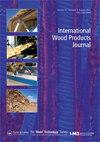10个杨树品种胶合板的一些特性
IF 0.9
Q2 MATERIALS SCIENCE, PAPER & WOOD
引用次数: 2
摘要
摘要本文旨在研究杨树品种和土壤对生长在不同土壤中的10个杨树品种生产的胶合板力学性能的可能影响。对于每个品种,每个站点收获两棵树;横切成螺栓,然后剥皮1.4毫米厚的一棵树和3毫米厚的另一棵树:共80棵树的采样。用两种胶粘剂:聚醋酸乙烯酯(PVAc)和三聚氰胺脲醛(MUF),将单板制成160块板。然后将这些板切割成标准化样品进行非破坏性和破坏性机械测试。通过测定胶合板的密度、弹性模量和断裂模量来表征胶合板的性能。结果表明,胶粘剂和单板厚度对杨木胶合板的性能有一定的影响。栽培和土壤效应不相关。破坏性和非破坏性弹性模量试验之间存在紧密的相关性。本文章由计算机程序翻译,如有差异,请以英文原文为准。
Some properties of plywood produced from 10 cultivars of poplar
ABSTRACT The aim of this paper is to study the possible influence of poplar cultivar and soil on the mechanical properties of plywood produced from 10 cultivars having grown in different soils. For each cultivar, two trees were harvested per station; crosscut into bolts then peeled 1.4 mm thick for one tree and 3 mm thick for the other one: in total, 80 trees were sampled. The veneers were used to make 160 boards using 2 adhesives: polyvinyl acetate (PVAc) and melamine-urea-formaldehyde (MUF). These boards were then cut into standardized samples for non-destructive and destructive mechanical tests. The properties of plywood were characterized by measuring their density, modulus of elasticity and modulus of rupture. The results showed that poplar plywood properties could be influenced by adhesive and veneer thickness. The cultivar and soil effects were never relevant. A tight correlation was found between destructive and non-destructive modulus of elasticity tests.
求助全文
通过发布文献求助,成功后即可免费获取论文全文。
去求助
来源期刊

International Wood Products Journal
MATERIALS SCIENCE, PAPER & WOOD-
CiteScore
2.40
自引率
0.00%
发文量
27
 求助内容:
求助内容: 应助结果提醒方式:
应助结果提醒方式:


